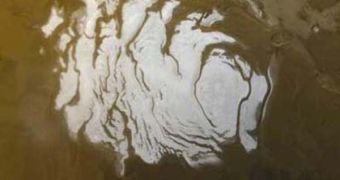According to an international study, published on Tuesday by French researchers, the massive ice cap at Mars' north pole is over 95 percent pure, and is thus made mostly of water. The news came as a shock to many people, because the implications of this are far-reaching. Biologists know that, wherever there is water, the chances of developing life are greater. Over time, the Mars Reconnaissance Orbiter (MRO) picked up numerous data on the Martian surface, including information about its ice caps and its glaciers, both hidden under a protective layer of rocky debris.
The France National Institute of Sciences of the Universe (INSU) has said in a statement that between two to three million cubic kilometers (0.47-0.72 million cubic miles) of ice adorn the polar regions of the Red Planet, and that this amount can be translated into 100 times the volume of water currently contained in the American Great Lakes. There are also pieces of information about hidden glaciers in some of the craters at middle latitudes, some kilometers-wide, which are also covered by debris.
Constantly, as new data is collected from NASA's vehicles around the planet, Mars' image as a desolate, dusty planet begins to fade away, and that of a former watery world starts to take its place. Since astronomers first discovered evidence that Mars might have held ice, they wondered about where the ice went when the planet became a desert. The INSU study appears in the journal Geophysical Research Letters, which is currently published by the American Geophysical Union.
“There's an even larger volume of water ice in the northern deposits. The fact these features are in the same latitude bands, about 35 to 60 degrees in both hemispheres, points to a climate-driven mechanism for explaining how they got there,” NASA's Jet Propulsion Lab (JPL) geologist Jeffrey J. Plaut says, talking about the fact that Martian glaciers exist even at mid-latitudes. “These results are the smoking gun pointing to the presence of large amounts of water ice at these latitudes,” Ali Safaeinili, who is a member of the team handling shallow-radar instruments at JPL, adds.
“A key question is, how did the ice get there in the first place? The tilt of Mars' spin axis sometimes gets much greater than it is now. Climate modeling tells us ice sheets could cover mid-latitude regions of Mars during those high-tilt periods. The buried glaciers make sense as preserved fragments from an ice age millions of years ago. On Earth, such buried glacial ice in Antarctica preserves the record of traces of ancient organisms and past climate history,” Brown University scientist James W. Head concludes.

 14 DAY TRIAL //
14 DAY TRIAL //